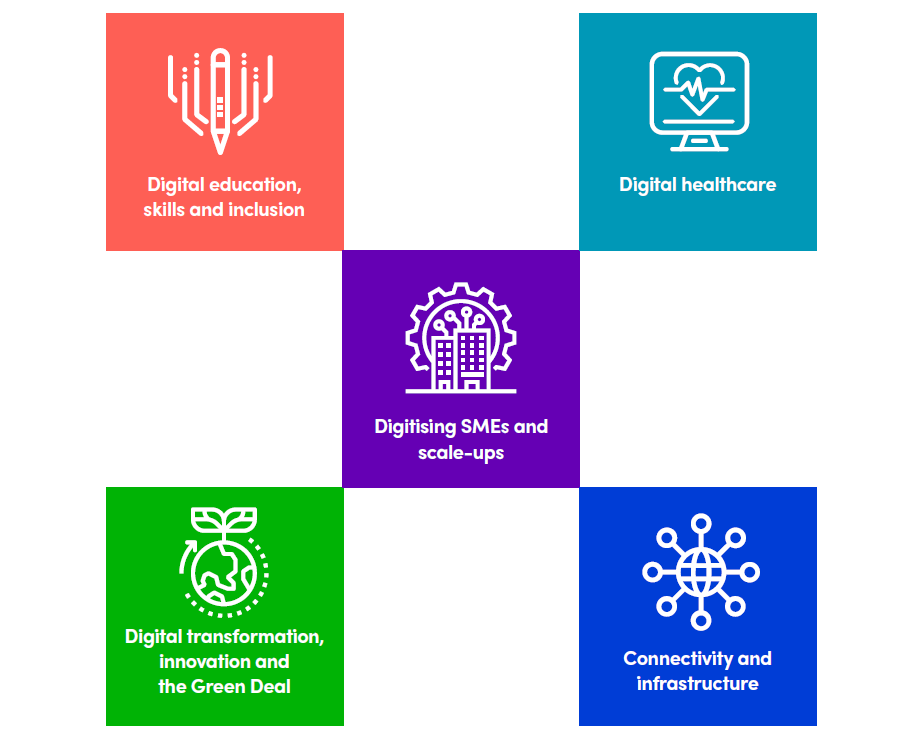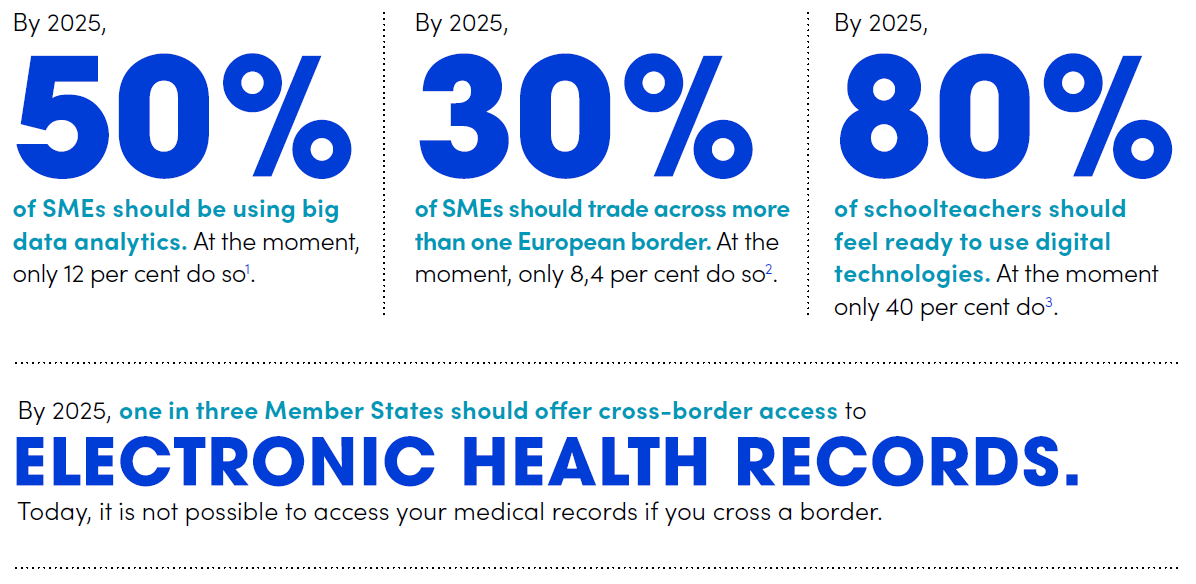
How to spend it: A digital investment plan for Europe
Foreword
Digital technologies have proved themselves to be essential for society and citizens during the COVID-19 crisis. As we retreated back into our homes and away from offices, schools, restaurants and large gatherings, digital solutions kept us in touch with what mattered. They are no longer simply “nice to have”.
Many citizens, businesses and public sector institutions have made a huge “digital leap” in the last few months. We have seen years’ worth of digital transformation in a few short months. Yet despite the gradual opening we are now seeing, the economic situation remains dire – the worst recession in decades, possibly centuries.
The investment decisions of today will shape Europe for the next five years, and speed is of essence. For example, before the crisis we knew that 52 per cent of the workforce needed to be reskilled over the next five years due to digitalisation. Now it looks like this must happen in the next 12 months, as millions have been made unemployed or have been placed on government furlough schemes.
The unprecedented common €750 billion stimulus package and 2021-2027 budget present a historic opportunity for Europe. There is a strong consensus that investment in digital technologies must be one of the pillars of the recovery.
Announced in President von der Leyen’s State of the Union speech and endorsed by European leaders, 20 per cent of the new recovery and resilience funding must be spent on digital investments.
What we must do is therefore clear. We must invest in digital to:
- Make sure we have the data and infrastructure to prevent, track and treat COVID-19 or other diseases in the future
- Develop our industry into one that is competitive, resilient, green, innovative and secure
- Accelerate the digital transformation of our public services
- Decrease our energy consumption
- Promote inclusion and create good, well-paying jobs in sectors that have a viable future
- Make sure that everyone has the skills to get a good job and participate in an increasingly digitised society, regardless of their background
- Connect rural areas into a digital inclusive society
- Protect critical digital infrastructure from cyberthreats
The question now is not if, but how.
In this paper we aim to point decision-makers both in Brussels and in the Member States in the right direction. We want to inspire as well as put forward visionary ideas for pan-European projects and member state investments.
In the pages that follow, you will see the types of projects that have the potential to take Europe forward and help it reinvent itself.
As a continent, we are now weakened by the COVID-19 crisis, but if we invest wisely we will emerge as a stronger digital Europe than before.
Hilary Mine, President, DIGITALEUROPE
Cecilia Bonefeld-Dahl, Director-General, DIGITALEUROPE
Executive summary
Earlier this year we outlined five broad priority areas for digital investment in our COVID-19 Recovery Plan:

Building on this, How to spend it: A digital investment plan for Europe is divided into two parts.
In the first part, we outline the ten investment ideas under each of these cross-cutting headings in more detail.
Digital education, skills and inclusion
- A European digital upskilling and reskilling programme
- Bringing schools into the digital age
- Using artificial intelligence to predict the jobs of the future
Digital healthcare
- Modernising and securing the EU’s health systems
- Harnessing health data to benefit patients and speed up research
Digitalising SMEs and scale-ups
- Boosting SME growth and cross-border trade through a Europe-wide e-Administration Portal
- Unlocking open public data to empower scale-ups
Digital transformation, innovation and the Green Deal
- A digital ‘Renovation Wave’ and a modernised construction sector
Connectivity and infrastructure
- Bridging the urban–rural digital divide
- Boosting growth of traditional sectors through 5G connectivity
In the second part, we outline concrete case studies from our members of digital projects at national level that could be scaled up and help achieve these aims.
These concrete case studies are intended to complement and illustrate the guidance provided by the Commission to Member States on priority digital flagship areas.
Our manifesto for a stronger digital Europe: 18 months on
Back in 2019, we released a set of 22 success indicators that Europe should aim to achieve by 2025. All of the investment ideas in this guide will help Europe reach these goals. In some cases, we have updated the KPIs, or added new ones, to take into account the changing circumstances.

Part I: Ten investment ideas for Europe's digital recovery

Digital education, skills and inclusion
According to European Commission figures, 42 per cent of European adults do not have basic digital skills. In addition, 52 per cent of the workforce need reskilling due to changes in the job market. At the same time, there are hundreds of thousands of unfilled vacancies for ICT professionals in Europe.
As highlighted in the European Skills Agenda and the Digital Education Action Plan, Member States and the relevant local authorities should prioritise digital skills.
Digital healthcare
Digital connectivity and tools have been instrumental in providing and expanding vital healthcare during the COVID-19 health crisis. Now is the time to build on and accelerate the digitisation we have started during the pandemic. This will ensure the resilience and preparedness of our healthcare systems for this and future crises, but it will equally address pre-existing challenges and create new opportunities.
The COVID-19 pandemic has exposed the lack of investment in and adoption of digital health solutions in Europe, leaving the potential of health data untapped and making health systems and organisations more vulnerable to crises.
Digitalising SMEs and scale-ups
As the backbone of the European economy and one of the hardest-hit sectors by the COVID-19 crisis, small and medium-sized enterprises (SMEs) need specific support.
The digitisation of SMEs can enable them to move their activities online and maintain operations in case of future lockdowns. As in previous crises, those companies that could adapt their business swiftly with the help of secure digital technologies are the most likely to survive. Streamlining processes and moving away from paper can also save costs and help businesses to expand.
Digital transformation, innovation, and the Green Deal
Digital has enormous enabling potential to facilitate the EU’s transition to a low carbon circular economy. According to a recent study, digital technologies have the potential to enable a 20 per cent reduction of global CO2 emissions by 2030, in particular in traditional sectors like energy, transport, construction, agriculture and manufacturing. That is ten times more than we produce as a sector.
Policymakers should mainstream digital in public investments, such as in cities and infrastructure, to support innovation and the transition to a more productive and sustainable economy. For instance, investments from public authorities in transport and urban planning should also be “smart” – i.e. digitalised.
One way to encourage industry-wide change would be a public-private partnership aimed at establishing a “digital lighthouse factory” in every traditional industry sector, from cement production to electronics manufacturing. Such a real-life, entirely digitized production site would not only demonstrate the potential of existing, commercially available technologies; it should also serve as vocational training centres and as research sites for academic and private partners, in particular start-ups, to learn and replicate innovative production methods.
Connectivity and infrastructure
Given the unprecedented transition to mass home working, living and leisure, the quality of connectivity will be more critical than ever. Connectivity will also enable strategic digital technologies like AI and IoT and will allow European companies to grow so that they can come out of the crisis stronger.
We need to ensure Europe has the right overall connectivity mix (submarine networks, fibre, 5G) capable of delivering what is required in terms of coverage, capacity, speed, latency, reliability, redundancy, and security to enable a modern and inclusive society to function properly, increase its potential in terms of value creation and competitiveness, also in challenging times of crisis.
Part II: Case studies

Download the full publication to discover all projects and stories by DIGITALEUROPE’s members






